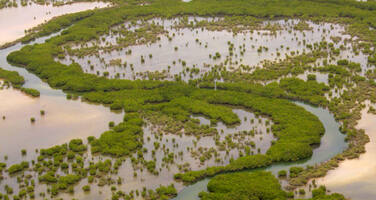Saloum Delta
Factors affecting the property in 2012*
- Erosion and siltation/ deposition
- Management systems/ management plan
International Assistance: requests for the property until 2012
Total amount approved : 0 USD
Missions to the property until 2012**
Conservation issues presented to the World Heritage Committee in 2012
The State Party submitted its report on 1 February 2012. It essentially provides an update on the implementation of the recommendations that the Committee had made in 2011, following the inscription of the property.
a) Management Plan
In the framework of the implementation of the Management Plan, several eco-guard training sessions were held in 2011 and were to be extended to the conservation of cultural elements. However, the subjects covered, the reports on which were appended to the State Party’s report, relate exclusively to the natural heritage, despite the Committee’s recommendation to ensure that cultural values be duly taken into consideration in the management and development programme. The Management Plan was formally circulated to all those involved in the management of the property. The establishment of the Toubacouta Interpretation Centre should be completed in 2012. The Order establishing the Saloum Delta Management and Safeguarding Committee has been issued and its enactment is in progress.
b) Implementation of other recommendations of the Committee
According to the State Party, the recent improvement in the condition of the mangrove contributes to better natural protection of the shell mounds, however preventive natural management of erosion must be studied. As for human waste management, the State Party notes that this issue remains a recurrent problem in the Delta, but experiments are underway.
The report of the State Party also refers to the preparation of an urban regulation for classified perimeters for which the future Management Committee will be responsible once it is finalized. On the issue of major development projects, the report notes that these are subject to environmental impact studies for the protection and conservation of the cultural elements of the property.
Regarding the provision of an annual monitoring report on the property, the State Party’s report indicates that it will be the responsibility of the Management Committee and its secretariat, once they are established.
Analysis and Conclusion by World Heritage Centre and the Advisory Bodies in 2012
The World Heritage Centre and Advisory Bodies consider that recent decisions by the State Party are in the right direction, and should be implemented without delay. However, they recommend that the Committee reiterate the urgency of giving special attention to protection of the shell mounds against erosion, good anthropogenic waste management, and the training of eco-guards in the cultural values of the property.
Summary of the interventions
Decisions adopted by the Committee in 2012
36 COM 7B.47
Saloum Delta (Senegal) (C 1359)
The World Heritage Committee,
1. Having examined Document WHC-12/36.COM/7B,
2. Recalling Decision 35 COM 8B.14, adopted at its 35th session (UNESCO, 2011),
3. Notes with satisfaction that the decisions taken by the State Party are steps in the right direction towards greater attention to the management of the cultural heritage of the property and encourages it to continue its efforts;
4. Requests the State Party to:
a) Continue to give priority attention to the simultaneous protection and conservation of cultural elements of the property and the natural elements associated with them,
b) Ensure that this joint protection and conservation is carried out at the same level on the entire property, in particular through the deployment of eco-guards over the entire site,
c) Establish a training programme for eco-guards in the cultural values of the property,
d) Continue studies and research on protection of the shell mounds against erosion by currents, as well as projects and technical research for better management of human waste and domestic waste within the property,
e) Develop a policy for monitoring the conservation of the property with clearly defined indicators and a regular programme of observation of these indicators;
5. Requests the State Party to submit to the World Heritage Centre, by 1 February 2014, a report on the state of conservation of the property.
Draft Decision: 36 COM 7B.47
The World Heritage Committee,
1. Having examined Document WHC-12/36.COM/7B,
2. Recalling Decision 35COM8B.14, adopted at its 35th session (UNESCO, 2011),
3. Notes with satisfaction that the decisions taken by the State Party are steps in the right direction towards greater attention to the management of the cultural heritage of the property and encourages it to continue its efforts;
4. Requests the State Party to:
a) Continue to give priority attention to the simultaneous protection and conservation of cultural elements of the property and the natural elements associated with them,
b) Ensure that this joint protection and conservation is carried out at the same level on the entire property, in particular through the deployment of eco-guards over the entire site,
c) Establish a training programme for eco-guards in the cultural values of the property,
d) Continue studies and research on protection of the shell mounds against erosion by currents, as well as projects and technical research for better management of human waste and domestic waste within the property,
e) Develop a policy for monitoring the conservation of the property with clearly defined indicators and a regular programme of observation of these indicators;
5. Requests the State Party to submit to the World Heritage Centre, by 1February 2014, a report on the state of conservation of the property.
Exports
* :
The threats indicated are listed in alphabetical order; their order does not constitute a classification according to the importance of their impact on the property.
Furthermore, they are presented irrespective of the type of threat faced by the property, i.e. with specific and proven imminent danger (“ascertained danger”) or with threats which could have deleterious effects on the property’s Outstanding Universal Value (“potential danger”).
** : All mission reports are not always available electronically.


